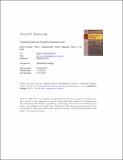Files in this item
Continental growth seen through the sedimentary record
Item metadata
| dc.contributor.author | Dhuime, Bruno | |
| dc.contributor.author | Hawkesworth, Chris J. | |
| dc.contributor.author | Delavault, Hélène | |
| dc.contributor.author | Cawood, Peter A. | |
| dc.date.accessioned | 2018-06-06T23:33:31Z | |
| dc.date.available | 2018-06-06T23:33:31Z | |
| dc.date.issued | 2017-07-15 | |
| dc.identifier | 250198215 | |
| dc.identifier | 313a3f1f-caf6-4662-93ca-975298fa7f96 | |
| dc.identifier | 85020479937 | |
| dc.identifier | 000406730500002 | |
| dc.identifier.citation | Dhuime , B , Hawkesworth , C J , Delavault , H & Cawood , P A 2017 , ' Continental growth seen through the sedimentary record ' , Sedimentary Geology , vol. 357 , pp. 16-32 . https://doi.org/10.1016/j.sedgeo.2017.06.001 | en |
| dc.identifier.issn | 0037-0738 | |
| dc.identifier.other | RIS: urn:957F72AAAA81B928961AC41E87A04672 | |
| dc.identifier.uri | https://hdl.handle.net/10023/13787 | |
| dc.description | This work was supported by the Natural Environment Research Council [NERC grant NE/K008862/1], the Leverhulme Trust [grant RPG-2015–422], and the Australian Research Council [grant FL160100168]. | en |
| dc.description.abstract | Sedimentary rocks and detrital minerals sample large areas of the continental crust, and they are increasingly seen as a reliable archive for its global evolution. This study presents two approaches to model the growth of the continental crust through the sedimentary archive. The first builds on the variations in U-Pb, Hf and O isotopes in global databases of detrital zircons. We show that uncertainty in the Hf isotope composition of the mantle reservoir from which new crust separated, in the 176Lu/177Hf ratio of that new crust, and in the contribution in the databases of zircons that experienced ancient Pb loss(es), adds some uncertainty to the individual Hf model ages, but not to the overall shape of the calculated continental growth curves. The second approach is based on the variation of Nd isotopes in 645 worldwide fine-grained continental sedimentary rocks with different deposition ages, which requires a correction of the bias induced by preferential erosion of younger rocks through an erosion parameter referred to as K. This dimensionless parameter relates the proportions of younger to older source rocks in the sediment, to the proportions of younger to older source rocks present in the crust from which the sediment was derived. We suggest that a Hadean/Archaean value of K = 1 (i.e., no preferential erosion), and that post-Archaean values of K = 4–6, may be reasonable for the global Earth system. Models built on the detrital zircon and the fine-grained sediment records independently suggest that at least 65% of the present volume of continental crust was established by 3 Ga. The continental crust has been generated continuously, but with a marked decrease in the growth rate at ~ 3 Ga. The period from > 4 Ga to ~ 3 Ga is characterised by relatively high net rates of continental growth (2.9–3.4 km3 yr−1 on average), which are similar to the rates at which new crust is generated (and destroyed) at the present time. Net growth rates are much lower since 3 Ga (0.6–0.9 km3 yr−1 on average), which can be attributed to higher rates of destruction of continental crust. The change in slope in the continental growth curve at ~ 3 Ga is taken to indicate a global change in the way bulk crust was generated and preserved, and this change has been linked to the onset of subduction-driven plate tectonics. At least 100% of the present volume of the continental crust has been destroyed and recycled back into the mantle since ~ 3 Ga, and this time marks a transition in the average composition of new continental crust. Continental crust generated before 3 Ga was on average mafic, dense, relatively thin (< 20 km) and therefore different from the calc-alkaline andesitic crust that dominates the continental record today. Continental crust that formed after 3 Ga gradually became more intermediate in composition, buoyant and thicker. The increase in crustal thickness is accompanied by increasing rates of crustal reworking and increasing input of sediment to the ocean. These changes may have been accommodated by a change in lithospheric strength at around 3 Ga, as it became strong enough to support high-relief crust. This time period therefore indicates when significant volumes of continental crust started to become emergent and were available for erosion and weathering, thus impacting on the composition of the atmosphere and the oceans. | |
| dc.format.extent | 17 | |
| dc.format.extent | 1145091 | |
| dc.language.iso | eng | |
| dc.relation.ispartof | Sedimentary Geology | en |
| dc.subject | Continental growth | en |
| dc.subject | Hadean/Archaean | en |
| dc.subject | Plate tectonics | en |
| dc.subject | Zircon | en |
| dc.subject | Shale | en |
| dc.subject | U-Pb/Hf/Nd/O isotopes | en |
| dc.subject | GE Environmental Sciences | en |
| dc.subject | QE Geology | en |
| dc.subject | NDAS | en |
| dc.subject | BDC | en |
| dc.subject.lcc | GE | en |
| dc.subject.lcc | QE | en |
| dc.title | Continental growth seen through the sedimentary record | en |
| dc.type | Journal article | en |
| dc.contributor.institution | University of St Andrews. School of Earth & Environmental Sciences | en |
| dc.contributor.institution | University of St Andrews. School of Geography and Geosciences | en |
| dc.contributor.institution | University of St Andrews. Scottish Oceans Institute | en |
| dc.contributor.institution | University of St Andrews. St Andrews Isotope Geochemistry | en |
| dc.identifier.doi | https://doi.org/10.1016/j.sedgeo.2017.06.001 | |
| dc.description.status | Peer reviewed | en |
| dc.date.embargoedUntil | 2018-06-06 |
This item appears in the following Collection(s)
Items in the St Andrews Research Repository are protected by copyright, with all rights reserved, unless otherwise indicated.

